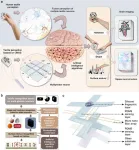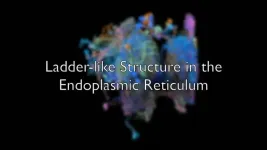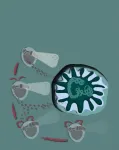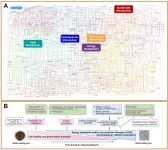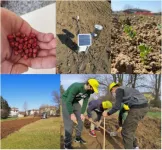(Press-News.org) Five years removed from the COVID-19 outbreak, scientists around the world are still studying its effects and, more importantly, ways those effects can be mitigated in the future. An international team of researchers may have just found a critical clue in the quest, and a laboratory at Texas Tech University played a key role.
The Ray Laboratory, led by Department of Biological Sciences Professor and Associate Chair David Ray, as part of a study on bat genomes published by the scientific journal Nature, helped identify the components of a genome in a specific species of bats that have shown more genetic adaptations in their immune systems than other animals.
The study revealed that a gene common in some bats can reduce the production of the SARS-CoV-2 virus by up to 90%, which could help lead to new medical approaches to combating viral diseases.
“Bats have an amazing ability to resist some of the worst effects of viral infection that make us so vulnerable to certain diseases,” Ray said. “While we get very sick, the bats barely blink an eye when exposed to the same pathogens.”
Ray said his laboratory aided in the annotation of the genome assemblies in the bats. Genome annotation is how scientists characterize all component parts of the genome – the genes, regulatory sequences and non-coding and coding regions. The Texas Tech lab identified the transposable element (TE) regions of the assemblies, where bits of DNA can create new copies of themselves and introduce variations within the genome.
Ray said bats have a unique TE repertoire among mammals, presenting a potentially powerful way to generate new genetic pathways to deal with pathogens like the coronavirus.
“If every individual of a species was genetically identical, they would all have the same risk associated with infection – if one dies, they all die,” Ray said. “TEs are a great way for organisms to generate genetic diversity in the species, allowing some individuals to survive better in the face of environmental pressures like viral diseases.”
This study is part of a larger international project called Bat1K, which is attempting to sequence and assemble the genomes of every living bat species, numbering around 1,500, according to Ray. It was led by the Senckenberg Research Institute and Natural History Museum in Frankfurt, Germany.
Michael Hiller, a professor of comparative genomics at the Goethe University and a member of the Senckenberg Institute is one of the main investigators in the study. He and Ray are both members of the executive board for the Bat1K consortium, and their relationship provided the perfect opportunity for Ray’s lab to collaborate with the international scientific community.
The lab studies genomes and genome evolution with an emphasis on TEs. Their past studies have included genome research on bats and other mammals, crocodiles and various insects. The lab has worked with entities in the past such as the National Science Foundation, the U.S. Department of Agriculture, the state of Texas and the Texas Department of Wildlife and Fisheries.
Researchers in this recent study paid particular attention to the ISG15 gene, which is associated with a severe course of COVID-19 in humans. Bats are known to carry numerous viruses, including those transmissible to humans, but do not show any symptoms of disease when infected.
The ISG15 gene from the bats, the study showed, is able to reduce production of the SARS CoV-2 virus by 80-90%. By contrast, the ISG15 gene from a human genome showed no antiviral effect in this study.
“Thus, the ISG15 gene is likely one of several factors that contribute to viral disease resistance in bats,” Hiller said. “These promising results can be used as a basis for further experimental studies, which are necessary to decipher the unique adaptations of the bats’ immune system.”
END
Texas Tech Lab plays key role in potential new pathway to fight viruses
2025-02-07
ELSE PRESS RELEASES FROM THIS DATE:
Multi-photon bionic skin realizes high-precision haptic visualization for reconstructive perception
2025-02-07
A new publication from Opto-Electronic Advances; DOI 10.29026/oea.2025.240152, discusses how multi-photon bionic skin realizes high-precision haptic visualization for reconstructive perception.
Human palm skin contains more than 20,000 tactile vesicles, depending on the tactile vesicles in the skin depth, activation threshold, trigger mode and other tactile signal pickup differences, as well as cross-synergistic mechanism between them, so that the skin can obtain different types of tactile signals. And then through the brain nerve center on the tactile signal “calculation” ...
Mitochondria may hold the key to curing diabetes
2025-02-07
Mitochondria are essential for generating energy that fuels cells and helps them function.
Mitochondrial defects, however, are associated with the development of diseases such as type 2 diabetes. Patients who suffer from this disorder are unable to produce enough insulin or use the insulin produced by their pancreas to keep their blood sugar at normal levels.
Several studies have shown that insulin-producing pancreatic β-cells of patients with diabetes have abnormal mitochondria and are unable to generate energy. Yet, these studies were unable to explain why the cells behaved this way.
In a study published in Science, ...
Researchers explore ketogenic diet’s effects on bipolar disorder among teenagers, young adults
2025-02-07
UCLA Health is set to begin a multi-site pilot study to explore whether a ketogenic diet, when combined with mood stabilizing medications, helps stabilize mood symptoms in teenagers and young adults who have bipolar disorder.
Preliminary research on the effects of a ketogenic diet in people with bipolar disorder have shown improvements in mood and in overall executive function, but these open trials have been limited to adults. This will be the first study conducted on the diet’s effects among youth and young adults with bipolar disorder.
Set ...
From muscle to memory: new research uses clues from the body to understand signaling in the brain
2025-02-07
Our biceps and our brain cells may have more in common than previously thought.
New research led by the Lippincott-Schwartz Lab shows that a network of subcellular structures similar to those responsible for propagating molecular signals that make muscles contract are also responsible for transmitting signals in the brain that may facilitate learning and memory.
“Einstein said that when he uses his brain, it is like he is using a muscle, and in that respect, there is some parallel here,” says Janelia Senior Group Leader Jennifer Lippincott-Schwartz. “The same machinery is operating in both cases ...
New study uncovers key differences in allosteric regulation of cAMP receptor proteins in bacteria
2025-02-07
Washington, D.C. – A new study, “Identifying Allosteric Hotspots in Mycobacterium tuberculosis cAMP Receptor Protein” published in Biochemistry, provides key insights into how bacterial cAMP receptor proteins (CRPs) respond differently to the ubiquitous signaling molecule, cyclic AMP (cAMP). By comparing the allosteric regulation of Escherichia coli CRP (CRPEcoli) and Mycobacterium tuberculosis CRP (CRPMTB), researchers challenge the assumption that structural similarity predicts functional behavior in allosteric proteins.
This ...
Co-located cell types help drive aggressive brain tumors
2025-02-07
A type of aggressive, treatment-resistant brain tumor has a distinct population of immune cells that support its growth, according to new research led by investigators at the Johns Hopkins Kimmel Cancer Center Bloomberg~Kimmel Institute for Cancer Immunotherapy and the Johns Hopkins University School of Medicine.
Searching for subtypes of immune cells seen only in the most serious, grade 4 brain tumors, called glioblastomas, and using a recently developed technology called spatial genomics, ...
Social media's double-edged sword: New study links both active and passive use to rising loneliness
2025-02-07
"The Epidemic of Loneliness: A Nine-Year Longitudinal Study of the Impact of Passive and Active Social Media Use on Loneliness" investigated how social media use impacts loneliness over time. This eye-opening research suggests that the very platforms designed to bring us together contribute to an "epidemic of loneliness."
The findings showed that both passive (PSMU) and active (ASMU) social media use were associated with increased feelings of loneliness over time. While passive social media use—like browsing without ...
An unexpected mechanism regulates the immune response during parasitic infections
2025-02-07
Researchers at the University of Liège (Belgium) have uncovered a previously unknown mechanism that regulates the immune response against parasites. During a parasitic infection, specific immune cells, known as virtual memory T cells (TVM), become activated and express a surface molecule called CD22, which prevents an excessive immune reaction. This discovery could help in better-controlling inflammation and improving immune responses to infections.
Nearly a quarter of the world's population ...
Scientists enhance understanding of dinoflagellate cyst dormancy
2025-02-07
Dinoflagellates play crucial roles in aquatic ecosystems, particularly as major contributors to harmful algal blooms. They can enter a dormant stage, known as the resting cyst stage, that allows them to survive for extended periods—up to 150 years—in marine sediments. This dormancy is essential for their annual population dynamics, blooming cycles, and geographic expansion.
Despite the ecological importance of resting cysts, the molecular mechanisms governing their dormancy, viability maintenance, and germination in natural sediments remain largely unexplored.
To better understand this process, researchers from the Institute of Oceanology, Chinese Academy of Sciences ...
PREPSOIL promotes soil literacy through education
2025-02-07
One of the eight key aims of the EU Mission Soil is to enhance soil literacy in society. As part of this effort, the PREPSOIL project is working to inspire teachers across Europe to integrate soil topics into their teaching. By identifying and promoting innovative examples of soil education, PREPSOIL aims to empower educators to engage students in exploring the vital role of soil in natural, urban, and agricultural environments.
In 2023 and 2024, teachers were invited to submit their best practices in soil education targeting primary, secondary, and vocational students. The initiative received over 50 submissions, showcasing a variety of creative and interdisciplinary ...
